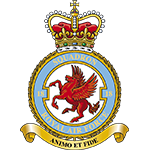RAF No 65 (East India) SquadronRAF No 65 (East India) Squadron
Motto: Vi Et Armis (By force of arms)
Formed on1 August 1916 at Wyton from a nucleus provided by Norwich training station, the squadron was equipped with a variety of training types until October 1917, when it received Camels. At the same time the squadron moved to France conducting defensive patrols until February 1918, when it started ground attack operations. A move to the Belgium coast came in August 1918 with the squadron escorting day bombers. It remained in Belgium until the end of war and returned to Yatesbury in February 1919, where it disbanded on 25 October 1919.
The squadron was reformed at Hornchurch on 1 August 1934 as a Demon fighter squadron. The squadron was reduced to cadre in September 1935 as personnel were drafted to Egypt to boast the strength of units taking part in the Abyssinian crisis. When the squadron began rebuilding to full strength in July 1936, it also received new equipment in the form of Gauntlets, thereby becoming a single seater fighter unit. Gladiators replaced the Gauntlets in June 1937 and in their turn were replaced by Spitfires from March 1939. Operations began with coverage of the Dunkirk evacuation after which it moved Kirton-in-Lindsay, returning to Hornchurch in June from where it took part in the Battle of Britain until the end of August.
Throughout 1941 and 1942, the squadron moved between bases in the south, the north of England and Scotland, carrying out defensive duties in the north and Scotland and offensive operations in the south and occasionally carrying out similar missions whilst based up north by operating from advanced bases in the south. In early 1943 the squadron carried out deck-landing training aboard HMS Argus, but then moved to Cornwall for coastal patrols and bomber escort duties. In May, the squadron joined 2nd Tactical Air Force and the following December converted to Mustangs, with which it operated in the fighter-bomber role up to the invasion.
The squadron moved to the continent at the end of June 1944 operating in the close support role until September, when it moved back to Matlask in Norfolk in the bomber-escort role. Another move to Scotland came in January 1945 where it provided similar support to the Strike Wings of Coastal Command operating along the Scandinavian coasts. A return to Norfolk in May 1945 brought conversion to Spitfires and then in July 1946 the squadron began to receive Hornet long-range fighters and the following month it moved to its peacetime base at Linton-on-Ouse. Meteor F Mk 4s began to arrive in December 1950 and conversion was complete by April 1951 and the following August, it re-located to Duxford. The squadron spent the next ten years at Duxford, re-equipping with Hunters in December 1956, disbanding on 31 March 1961. The squadron reformed on 1 January 1964 as a surface-to-air missile unit at Seletar equipped with Bloodhound Mk 2s, disbanding on 30 March 1970.
Since then the squadron number has been allocated to No 226 OCU, equipped with Lightnings at Coltishall from 1 September 1970 until 17 Jun 1974 and then No 229 OCU flying Tornadoes at Coningsby from 31 December 1986 to 30 June 1992, when the OCU was re-numbered No 56 (Reserve) Squadron.
Standards Battle Honours*
Award of Standard originally announced on 15 Oct 1957, effective from 1 Apr 1957 but presented:-16 October 1957
MRAF Sir William Dickson
Western Front, 1917-1918: Cambrai, 1918: Somme, 1918: France & Low Countries: Dunkirk: Battle of Britain, 1940: Home Defence, 1940-42: Fortress Europe, 1941-1944: Channel & North Sea, 1942-1945: Dieppe: Normandy, 1944: Arnhem: France & Germany, 1944-1945: Baltic 1945:
Squadron Codes used: -FZ Oct 1938 - Sep 1939
YT Sep 1939 - Apr 1951

 Editor for Asisbiz: Matthew Laird Acred
Editor for Asisbiz: Matthew Laird Acred
If you love our website please subscribe to our YouTube video channel
Please donate so we can make this site even better !!

